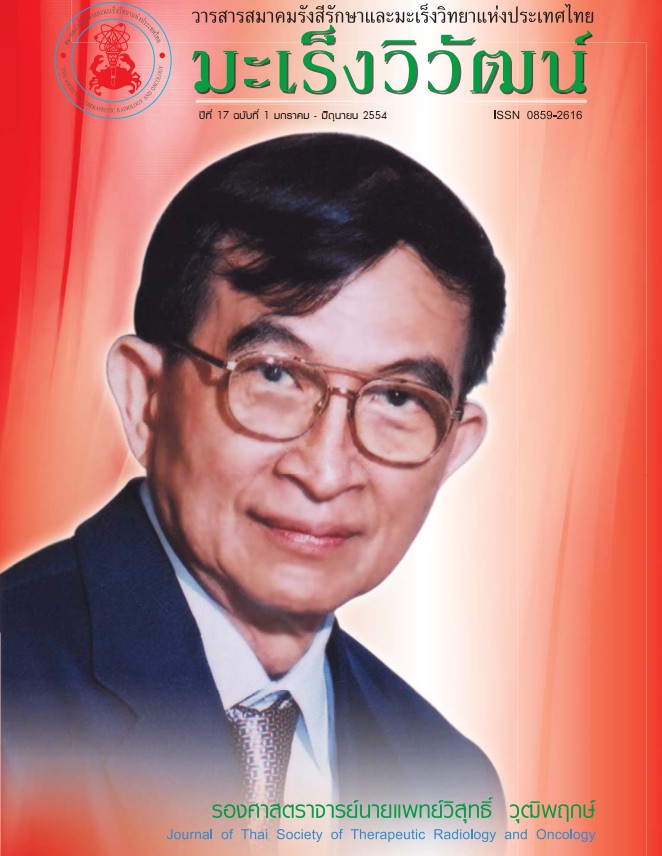ผลการรักษาผู้ป่วยมะเร็งปากมดลูก ด้วยการให้รังสีระยะใกล้ชนิดอัตราการแผ่ปริมาณรังสีสูงด้วยสารกัมมันตรังสีโคบอลต์-60 ชนิดที่มีขนาดเล็กที่ได้รับการรักษา ณ ศูนย์ป้องกันและควบคุมโรคมะเร็งจังหวัดลำปาง
Keywords:
External beam radiotherapy, HDR brachytherapy, Co-60 source, cervical cancer, toxicityAbstract
วัตถุประสงค์ : เพื่อศึกษาถึงผลการรักษาและภาวะแทรกซ้อนที่มีต่อระบบทางเดินอาหารและระบบทาง เดินปัสสาวะในผู้ป่วยมะเร็งปากมดลูกที่ได้รับการรักษาด้วยการฉายรังสีจากภายนอกตามด้วยการสอดใส่แร่ชนิด อัตราการแผ่ปริมาณรังสีสูงด้วยสารกัมมันตรังสีโคบอลต์ 60 รูปแบบการศึกษา : การศึกษาวิจัยเชิงพรรณนาแบบศึกษาย้อนหลัง วิธีการศึกษา : ได้ทำการรวบรวมข้อมูลจากบันทึกทางการแพทย์ของผู้ป่วยที่เข้ารับการรักษาที่ศูนย์ควบคุม และป้องกันโรคมะเร็งจังหวัดลำปางด้วยโรคมะเร็งปากมดลูกระยะที่ 1-3 ที่ได้รับการรักษาด้วยการฉายรังสีจาก ภายนอกตามด้วยการสอดใส่แร่ชนิดอัตราการแผ่ปริมาณรังสีสูงด้วยสารกัมมันตรังสีโคบอลต์ 60 ระหว่าง1 ธันวาคม 2550-31 กรกฎาคม พ.ศ.2553 โดยเก็บรวบรวมข้อมูลพื้นฐานของผู้ป่วย การให้รังสีรักษา ผลการรักษา และภาวะ แทรกซ้อนที่มีต่อระบบทางเดินอาหารและระบบทางเดินปัสสาวะโดยใช้ Common Terminology Criteria of Adverse Events(CTCAE) version 3.0 ผลการศึกษา : ผู้ป่วยจำนวน 46 รายอายุเฉลี่ยเท่ากับ 59.5 ปี เป็นมะเร็งปากมดลูกระยะที่ IIB 52.2% ระยะ IIIB 30.4% ได้รับการฉายรังสีรักษาจากภายนอก 50 Gy ตามด้วยการสอดใส่แร่ชนิดอัตราการแผ่ปริมาณรังสี สูงด้วยสารกัมมันตรังสีโคบอลต์ 60 6.5 Gy 4ครั้ง ระยะเวลาของการรักษาเฉลี่ย 56 วัน ค่า total BED Gy10 ที่ก้อนมะเร็งได้รับเท่ากับ 90.9(75.8-107.5) ค่า BED Gy3 ที่ลำไส้ตรงได้รับเท่ากับ 111.15 Gy(78.60-210.70) ค่า BED Gy3 ที่กระเพาะปัสสาวะได้รับเท่ากับ 101.80 Gy(76.80-171.80) ผลการรักษาพบว่ามี complete response 44 ราย(95.6%) ภาวะแทรกซ้อนระยะเฉียบพลันระบบ gastrointestinal system ที่พบบ่อย ได้แก่ ภาวะ diarrhea 11 ราย(23.9%) เป็นความรุนแรงระดับ 1 และ 2 จำนวน10 ราย (21.7%) ความรุนแรงระดับ 3 จำนวน1 ราย (2.2%) ภาวะแทรกซ้อนระยะเฉียบพลันทางระบบ genitourinary system ที่พบบ่อยได้แก่ภาวะ urinary frequency 9 ราย (19.5%) ทั้งหมดเป็นความรุนแรงระดับ 1 และ 2 ภาวะแทรกซ้อนระยะยาวที่พบได้แก่ภาวะ proctitis 6 ราย(13.0%) เป็นความรุนแรงระดับ 1 5 ราย (10.8%) ความรุนแรงระดับ 3 1 ราย(2.2%) สรุป : การรักษามะเร็งปากมดลูกด้วยการฉายรังสีจากภายนอกร่วมกับการสอดใส่แร่ชนิดอัตราการแผ่ ปริมาณรังสีสูงด้วยการกัมมันตรังสีโคบอลต์-60 ที่มารับการรักษาที่ศูนย์ควบคุมและป้องกันโรคมะเร็งจังหวัด ลำปางสามารถให้ผลการรักษาที่ดี และมีภาวะแทรกซ้อนต่ำ การศึกษาในอนาคตทำให้สามารถนำมาใช้เทียบ เคียงกับการรักษาโดยใช้สารกัมมันตรังสีชนิดอื่นได้
References
National Cancer Institute. Cancer in Thailand vol.5, 2001-2003, Department of Medical Service, Ministry of Public Health, Thailand 2010.
Lampang Cancer Center. Cancer incidence in Northern Thailand 2003-2007, Hospital Cancer Registry 2009, Ministry of Public Health,Thailand 2009.
Keys HM, Bundy BN, Stehman FB, et al. Cisplatin, radiation and adjuvant hysterectomy compared with radiation and adjuvant hysterectomy for bulky stage IB cervical cancer. N Engl J Med 1999;340:1154-61.
Whitney CW, Sause W, Bundy BN, et al. Randomized comparison of fl uorouracil plus cisplatin versus hydroxyurea as an adjunct to radiation therapy in stage IIB-IVA carcinoma of the cervix with negative lymph nodes: A Gynecologic Oncology and Southwest Oncology Group study. J Clin Oncol 1999;17:1339-48.
Morris M, Eifel PJ, Lu J et al. Pelvic radiation with concurrent chemotherapy compared with pelvic and para-aortic radiation for high-risk cervical cancer. N Engl J Med 1999;340:1137-43.
Rose PG, Bundy BN, Watkins EB, et al. Concurrent cisplatin-based radiotherapy and chemotherapy for locally advanced cervical cancer. N Engl J Med 1999;340:1144-53.
Peter WA III, Lui PY, Barrett RJ II, et al. Concurrent chemotherapy and pelvic radiation therapy compared with pelvic radiation alone as adjuvant therapy after radical surgery in high-risk early stage cancer of the cervix. J Clin Oncol 2000;18:1606-13.
Green JA, Kirwan JM, Tierney JF, et al. Survival and recurrence after concomitant chemotherapy and radiotherapy for cancer of the uterine cervix; a systematic review and meta-analysis. Lancet 2001;358:781-6.
Lukka H, Hirte H, Fyles A, et al. Concurrent cisplatin-based chemotherapy plus radiotherapy for cervical cancer—A meta-analysis. Clin Oncol 2002;14:203-12.
Chao KS, Perez CA, Brady LW, et al. Physics and Dosimetry of High-Dose-Rate brachytherapy in Radiation Oncology Management Decisions (2nd Edition). Lippincott Williams & Wilkins. Philadelphia. 2002;89-94.
Ballester F, Granero D, Peres-Calayud J. Monte Carlo dosemetic study of the BEBIG Co-60 HDR source. Phys Med Biol. 2005;50:N309-16.
Cho JH, Kim HC, Sur CO, et al. Optimum Radiotherapy Schedule for Uterine Cervical Cancer based-on the Detailed Information of Dose Fractionation and Radiotherapy Technique. J of Korean Soc of Ther Radiology and Oncology. 2005;23(3):143-56.
Nag S, Dally M, Torre M. Recommendations for Implementation of high dose rate 192 Iridium brachytherapy in developing countries by the advisory group of IAEA. Radiotherapy and Oncology. 2002;64:297-308.
Nag S, Erickson B, Orton C, et al. The American Brachytherapy Society Recommendations for high dose rate brachytherapy for carcinoma of the cervix. Int J Radiat Oncol Biol Phys. 2000;48:201-11.
Atara N, Adeniyi A, Bidemi A, et al. High-dose-rate brachytherapy in the treatment of cervical cancer: Preliminary experience with cobalt 60 radionuclide source. Clinical Medicine Insights: Oncology 2010;4:89-94.
Jain VS, Sarje MB, Singh KK, et al. High-dose-rate-intracavitary brachytherapy applications and the difference in the bladder and rectum doses: A study from rural center of Maharashatra, India. J of Cancer Res and Ther. 2007;3(2):116-20.
Petereit D, Fowler JF. High-dose-rate brachytherapy—high-dose, high tech, and high results. Int J Radiation Oncology Biol Phys. 2003;55(5):1159-61.
Mandal A, Asthana AK, Aggarwal LM. Clinical signifi cance of cumulative biological effective dose and overall treatment time in the treatment of carcinoma cervix. J of Med Phys. 2007;32(2):68-72.
Chen S-W, Liang J-N, Hung Y-c, et al, Concurrent weekly cisplatin plus external beam radiotherapy and high-dose rate brachytherapy for advanced cervical cancer : A control cohort comparison with radiation alone on treatment outcome and complications.
Int J Radiation Oncology Biol Phys.2006;66(5):1370-77.
Ferrigno R, Novaes ER, Pellizzon AC, et al. High-dose rate brachytherapy in the treatment of uterine cervix cancer. Analysis of dose effectiveness and late complications. Int J Radiation Oncology Biol Phys. 2001;50(5):1123-35.
Mosalaei M, Mohammadinapanah M, Omidvari S, et al. High-dose rate brachytherapy in the treatment of carcinoma of uterine cervix: twenty year experience with cobalt after-loading system. Int J Gynecol Cancer. 2006;16;1101-5.
Downloads
Published
How to Cite
Issue
Section
License
บทความที่ได้รับการตีพิมพ์เป็นลิขสิทธิ์ของวารสารมะเร็งวิวัฒน์ ข้อความที่ปรากฏในบทความแต่ละเรื่องในวารสารวิชาการเล่มนี้เป็นความคิดเห็นส่วนตัวของผู้เขียนแต่ละท่านไม่เกี่ยวข้องกับ และบุคคลากรท่านอื่น ๆ ใน สมาคมฯ แต่อย่างใด ความรับผิดชอบองค์ประกอบทั้งหมดของบทความแต่ละเรื่องเป็นของผู้เขียนแต่ละท่าน หากมีความผิดพลาดใดๆ ผู้เขียนแต่ละท่านจะรับผิดชอบบทความของตนเองแต่ผู้เดียว




